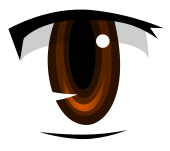Children's anime and manga
Children's manga (子供向け漫画 Kodomo-muke manga) and children's anime (子供向けアニメ Kodomo-muke anime) are Japanese terms which literally mean "manga (or "anime", respectively) directed towards children 5 to 8 years of age". Children's manga are also known by the word "Kodomo", or "child".[1] These series are usually moralistic, teaching kids to stay in the right path in life. The series are generally stand-alone, or non-episodic. Doraemon by Fujiko F. Fujio is one of the most notable examples for this manga/anime demographic, as well as anime like Pokémon.[2]
History
The genre started in the late 19th century with the production of short manga, approximately 15 pages long, printed in magazines. These short manga were created as a part of the Meiji era's attempt to encourage literacy amongst Japanese youth. A major milestone in the popularity of Japanese animation was the creation of Astro Boy, by Osamu Tezuka, who is often considered the father of Japanese animation. [3]
Children's anime and manga can be divided into four categories. The first category is anime and manga adaptations of Western stories. One example is World Masterpiece Theater. Most of them are TV series. Despite being popular, they are less representative of traditional Japanese anime. Instead, they are modeled after classical American or Soviet cartoons.
The second category is unique to Japan. These are manga adaptations and original works. They use linguistic gags, contain references to Japanese society, and may be harder to understand for non-Japanese viewers. They are in some ways similar to American animation such as South Park or The Simpsons. An example is Chibi Maruko-chan. Within the storyline, these works contain shōnen elements.
The third category is cute anime, popular amongst teenage girls. Examples include Hello Kitty. Another category that is closer to shōnen is Pokémon. These shows have a connection with popular video game and toy markets, and have the greatest commercial success.[4]
Magazines such as CoroCoro Comic, first published by Shogakukan, primarily target young boys, especially those in elementary school. Kodansha's Comic BomBom also published children's manga targeted at young boys. Both of these magazines are released monthly in Japan. Popular children's manga is also reinvented as anime and is accompanied by a plethora of merchandise. Despite it being aimed at children, children's anime and manga is popular among an older audience. Similarly, shōjo anime like Tokyo Mew Mew or Shugo Chara! are also popular among the "tween" audience.[5]
Awards
The annual Shogakukan Manga Award and Kodansha Manga Award each include a category for children's manga.[6][7] The Shogakukan Manga awards first included a category for children's manga in 1981. The Kodansha Manga awards also has a category for children's manga.
See also
- Shōnen manga: Manga intended for teen boys
- Shōjo manga: Manga intended for teen girls
- Seinen manga: Manga intended for mature men
- Josei manga: Manga intended for mature women
- Myungrang manhwa: Korean comics intended for children
References
- ↑ "Kodomo". Anime News Network. Retrieved September 2, 2012.
- ↑ Thompson, Jason. Manga: The Complete Guide. Del Rey Manga.
- ↑ Zagzoug, Marwah. "The History of Anime & Manga". nova online. C.T. Evans. Retrieved March 2, 2015.
- ↑ "10.3 — Кодомо-аниме" (in Russian). Archived from the original on September 10, 2014. Retrieved February 27, 2013.
- ↑ "Kodomo Genere". Jappleng University. Retrieved March 26, 2014.
- ↑ "57th Shogakukan Manga Awards". Shogakukan. Retrieved September 2, 2012.
- ↑ "36th Kodansha Manga Award". Kodansha. Retrieved September 2, 2012.
